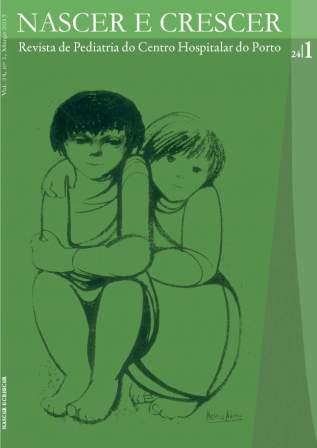Procedimento intraparto extra-uterino (EXIT) num caso de linfangiona cervical
DOI:
https://doi.org/10.25753/BirthGrowthMJ.v24.i1.8575Palavras-chave:
cesariana, EXIT, feto, linfangiomaResumo
Introdução: Fetos com diagnóstico pré-natal de malformações anatómicas envolvendo a face e/ou o pescoço estão em risco de obstrução das vias aéreas desde o pós-natal imediato. A programação de medidas periparto que previnam a compressão das vias aéreas, mantendo uma adequada circulação fetal, é fundamental no prognóstico.
Caso Clínico: Feto com diagnóstico ecográfico, às 31 semanas de gestação, de volumosa massa cervical e facial, compatível com linfangioma quístico. O caso foi discutido em equipa multidisciplinar, tendo sido decidida a realização de cesariana associada ao procedimento EXIT às 39 semanas de gestação. Após exteriorização do polo cefálico, foi confirmada massa cervical e facial direita, sendo o feto sujeito a intubação oro-traqueal no primeiro minuto. Ao sexto dia de vida foi submetido a cirurgia, com excisão parcial da massa.
Conclusão: O procedimento EXIT permite a manutenção de uma adequada oxigenação fetal enquanto se estabelece uma via aérea patente. Uma adequada coordenação da equipa multi-disciplinar é fundamental para o êxito da técnica.
Downloads
Referências
Helfer DC, Clivatti J, Yamashita AM, TSA, Moron AF. Anestesia para tratamento intraparto extraútero (EXIT) em fetos com diagnóstico pré-natal de malformações cervical e oral: Relato de casos. Rev Bras Anestesiol 2012; 62:3:411-23.
Braga AFA, Frias JAF, Braga FSS, Rousselet MS, Barini R, Sbragia L, et al. Anestesia para tratamento intraparto extra-útero em feto com diagnóstico pré-natal de higroma na região cervical. Relato de caso. Rev Bras Anestesiol 2006; 56:3:278-86.
Nascimento GC, Rolland de Souza AS, Lima MMS, Guerra GV, Meneses JA, Cardoso AS, et al. Estratégia de conduta intraparto no teratoma cervical congénito – procedimento EXIT (Tratamento Extra-Útero Intraparto). Acta Med Port 2007; 20:221-7.
Oluyinka OO, Olutoye AO. EXIT procedure for fetal neck masses. Curr Opin Pediatr 2012, 24:386-93.Kenneth J, Moise Jr MD, Anthony Johnson DO. Management of twin-twin transfusion syndrome. UpToDate, Fevereiro 2013.
Chiu HH, Hsu WC, Shih JS, Tsao PN, Hsieh WS, Chou HC. The EXIT (Ex Utero Intrapartum Treatment) Procedure- Case report. J Formos Med Assoc 2008; 107:745-8.
De Backer A, Madern GC, Van de Ven CP. Strategy for management of newborns with cervical teratoma. J Perinat Med 2004; 32:500-8.
Mychaliska GB, Bealer JF, Graf JL. Operating on placental support: the ex utero intrapartum treatment procedure. J Pediatr Surg 1997; 32:227-31.
Pellicer M, Pumarola F, Peiró JK, Ibáñez VM, Vaquero JAG, Carreras E, et al. EXIT Procedure in the Management of Severe Foetal Airway Obstruction. Acta Otorrinolaringol Esp 2007; 58:487-90.
Vasconcelos BN, Benez MDV, Bressan AL, Oliveira EF. Higroma cístico da face com involucão após infecção local. An Bras Dermatol 2011; 86:135-7.
Tekșam M, Özyer U, McKinney A, Kırbaș İ. MR imaging and ultrasound of fetal cervical cystic lymphangioma: utility in antepartum treatment planning. Diagn Interv Radiol 2005; 11:87-9.
Downloads
Publicado
Como Citar
Edição
Secção
Licença
Copyright e Direitos dos Autores
Todos os artigos publicados na Revista Nascer e Crescer – Birth and Growth Medical Journal são de acesso aberto e cumprem os requisitos das agências de financiamento ou instituições académicas. Relativamente à utilização por terceiros a Nascer e Crescer – Birth and Growth Medical Journal rege-se pelos termos da licença Creative Commons "Atribuição - Uso Não-Comercial - (CC-BY-NC)"".
É da responsabilidade do autor obter permissão para reproduzir figuras, tabelas, etc. de outras publicações.
Juntamente com a submissão do artigo, os autores devem enviar a Declaração de conflito de interesses e formulário de autoria. Será enviado um e-mail ao autor correspondente, confirmando a receção do manuscrito.
Os autores ficam autorizados a disponibilizar os seus artigos em repositórios das suas instituições de origem, desde que mencionem sempre onde foram publicados e de acordo com a licença Creative Commons.


